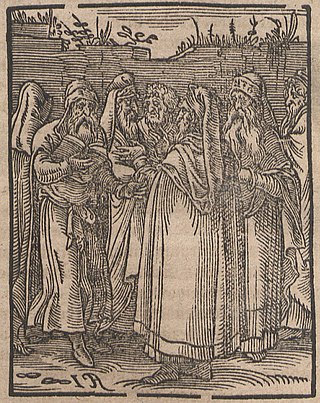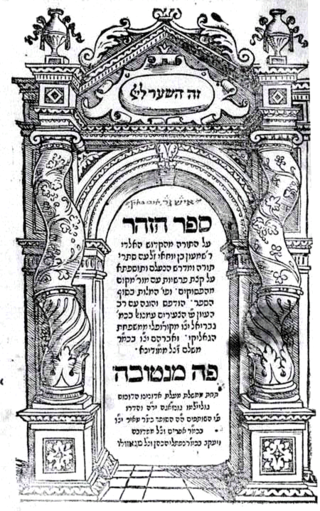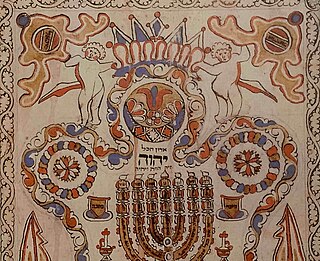
Kabbalah or Qabalah is an esoteric method, discipline and school of thought in Jewish mysticism. A traditional Kabbalist is called a Mekubbal. The definition of Kabbalah varies according to the tradition and aims of those following it, from its origin in medieval Judaism to its later adaptations in Western esotericism. Jewish Kabbalah is a set of esoteric teachings meant to explain the relationship between the unchanging, eternal God—the mysterious Ein Sof —and the mortal, finite universe. It forms the foundation of mystical religious interpretations within Judaism.

A siddur is a Jewish prayer book containing a set order of daily prayers. The word siddur comes from the Hebrew root ס־ד־ר, meaning 'order.'

The Zohar is a foundational work of Kabbalistic literature. It is a group of books including commentary on the mystical aspects of the Torah and scriptural interpretations as well as material on mysticism, mythical cosmogony, and mystical psychology. The Zohar contains discussions of the nature of God, the origin and structure of the universe, the nature of souls, redemption, the relationship of Ego to Darkness and "true self" to "The Light of God".

Rabbinic literature, in its broadest sense, is the entire spectrum of rabbinic writings throughout Jewish history. However, the term often refers specifically to literature from the Talmudic era, as opposed to medieval and modern rabbinic writing, and thus corresponds with the Hebrew term Sifrut Chazal. This more specific sense of "Rabbinic literature"—referring to the Talmudim, Midrash, and related writings, but hardly ever to later texts—is how the term is generally intended when used in contemporary academic writing. The terms mefareshim and parshanim (commentaries/commentators) almost always refer to later, post-Talmudic writers of rabbinic glosses on Biblical and Talmudic texts.

Isaac ben Solomon Luria Ashkenazi, commonly known in Jewish religious circles as Ha'ari, Ha'ari Hakadosh or Arizal, was a leading rabbi and Jewish mystic in the community of Safed in the Galilee region of Ottoman Syria, now Israel. He is considered the father of contemporary Kabbalah, his teachings being referred to as Lurianic Kabbalah.
The Dardaim or Dor Daim, are adherents of the Dor Deah movement in Orthodox Judaism. That movement took its name in 1912 in Yemen under Rabbi Yiḥyah Qafiḥ, and had its own network of synagogues and schools, although, in actuality, the movement existed long before that name had been coined for it. According to ethnographer and historian, Shelomo Dov Goitein, author and historiographer, Hayyim Habshush had been a member of this movement before it had been given the name Dor Deah, writing, “...He and his friends, partly under European influence, but driven mainly by developments among the Yemenite Jews themselves, formed a group who ardently opposed all those forces of mysticism, superstition and fatalism which were then so prevalent in the country and strove for exact knowledge and independent thought, and the application of both to life.” It was only some years later, when Rabbi Yihya Qafih became the headmaster of the new Jewish school in Sana'a built by the Ottoman Turks and where he wanted to introduce a new curriculum in the school whereby boys would also learn arithmetic and the rudiments of the Arabic and Turkish languages that Rabbi Yihya Yitzhak Halevi gave to Rabbi Qafih's movement the name Daradʻah, a word which is an Arabic broken plural made-up of the Hebrew words Dör Deʻoh, and which means "Generation of Knowledge."

Tzadik is a title in Judaism given to people considered righteous, such as biblical figures and later spiritual masters. The root of the word ṣadiq, is ṣ-d-q, which means "justice" or "righteousness". When applied to a righteous woman, the term is inflected as tzadika/tzaddikot.

Keter or Kether is the topmost of the sephirot of the Tree of Life in Kabbalah. Since its meaning is "crown", it is interpreted as both the "topmost" of the Sephirot and the "regal crown" of the Sephirot. It is between Chokhmah and Binah and it sits above Tiferet. It is usually given three paths, to Chokhmah, Tiferet and Binah.

Rabbi Yehuda Ashlag (1885–1954) or Yehuda Leib Ha-Levi Ashlag, also known as the Baal Ha-Sulam in reference to his magnum opus, was an orthodox rabbi and kabbalist born in Łuków, Congress Poland, Russian Empire, to a family of scholars connected to the Hasidic courts of Porisov and Belz. Rabbi Ashlag lived in the Holy Land from 1922 until his death in 1954. In addition to his Sulam commentary on the Zohar, his other primary work, Talmud Eser Sefirot is regarded as the central textbook for students of Kabbalah. Ashlag systematically interpreted the wisdom and promoted its wide dissemination. In line with his directives, many contemporary adherents of Ashlag's teachings strive to spread Kabbalah to the masses.

Sefirot, meaning emanations, are the 10 attributes/emanations in Kabbalah, through which Ein Sof reveals itself and continuously creates both the physical realm and the chain of higher metaphysical realms. The term is alternatively transliterated into English as sephirot/sephiroth, singular sefirah/sephirah, etc.

Shlomo ha-Levi Alkabetz, also spelt Alqabitz, Alqabes; was a rabbi, kabbalist and poet perhaps best known for his composition of the song Lecha Dodi.
Assiah is the last of the four spiritual worlds of the Kabbalah based on the passage in Isaiah 43:7. It is identical with the existing world that we live in.
Tzidkatcha is a prayer consisting of group of three verses that is recited during the afternoon prayer on Shabbat. It is said in memory of three righteous individuals who died on Shabbat: Joseph, Moses and King David. It is recited at this prayer in particular because these individuals died in the afternoon.
Baruch HaShem Le'Olam is a compilation of 18 verses from Tanach that is recited by some minyanim during weekday Maariv between Shema and Amidah. Its name is from the first 3 words of the first verse.
Partzufim/Partsufim, meaning "Divine Personas", are particular reconfigured arrangements of the ten sefirot, divine attributes/emanations of Kabbalah. Each partzuf is thus a configuration of disparate entities into a harmonious unit. The names of the partzufim are derived from the Zohar, the foundational text of Kabbalah. There, they are synonymous terms for the sefirot. Their full doctrinal significance emerged in 16th century Lurianic Kabbalah with reference to the cosmic processes of Tohu and Tikun, "Chaos and Rectification".
Arich Anpin or Arikh Anpin (Aramaic: אריך אנפין meaning "Long Face/Extended Countenance" is an aspect of Divine emanation in Kabbalah, identified with the sephirah attribute of Keter, the Divine Will.
Olam HaTohu and Olam HaTikun are two general stages in Jewish Kabbalah in the order of descending spiritual worlds known as "the Four Worlds". In subsequent creation, they also represent two archetypal spiritual states of being and consciousness. Their concepts derive from the new scheme of Lurianic Kabbalah by Isaac Luria (1534–1572), the father of modern Kabbalah, based on his interpretation of classic references in the Zohar.
Tikunei haZohar, also known as the Tikunim (תקונים), is a main text of the Kabbalah which was composed in the 14th century.
Ana BeKoach is a piyyut recited by Jewish communities at the end of Parshat HaKorbanot read during Shacharit, as part of Kabbalat Shabbat, and on each day from the second day of Pesach to the day before Shavuot during the 49-day counting of the Omer. It takes its name from the first two words of the first verse.









